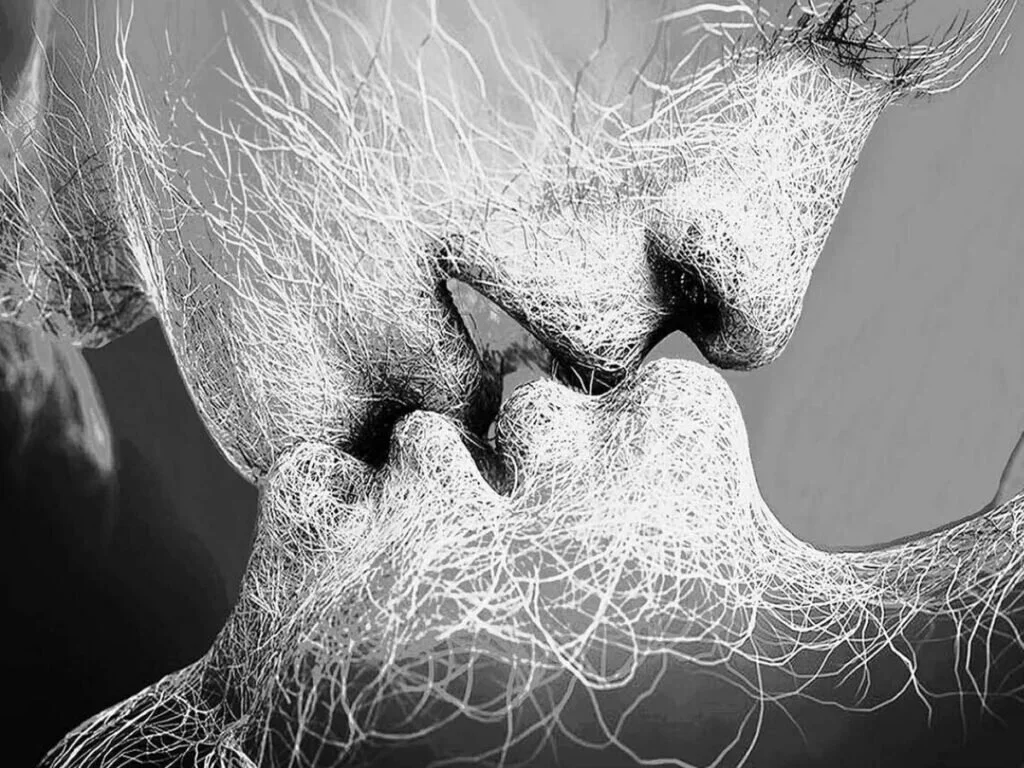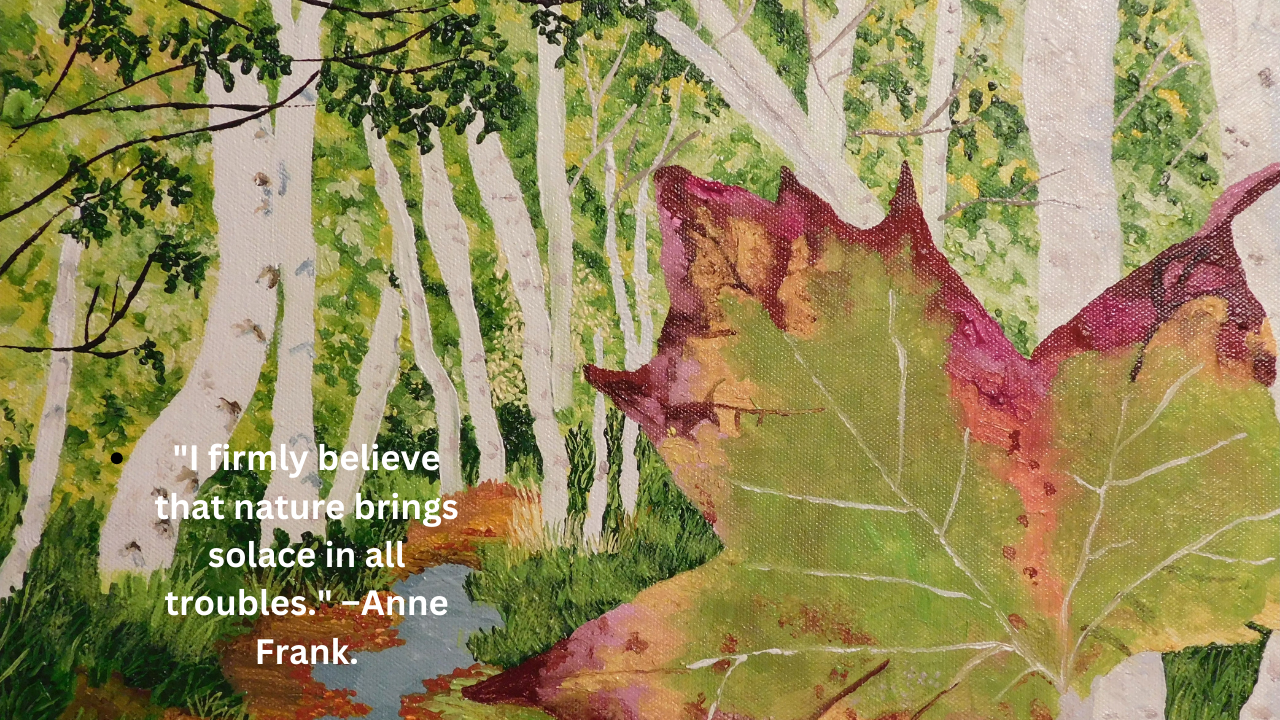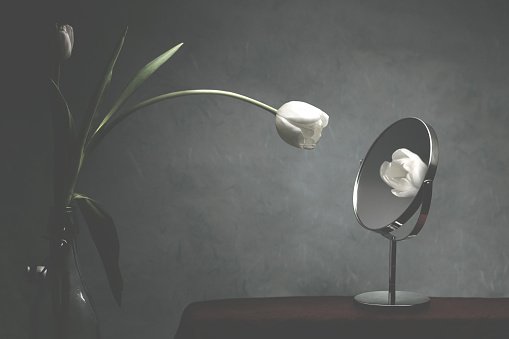Is This a Metaphorical Kiss?
A kiss is a simple gesture. But in black and white, it becomes something else.
Less literal. More symbolic.
This image shows two faces touching, yet the details are reduced to lines and light. The familiar shape is still there, but the texture feels almost electric. As if connection has been stripped down to its raw energy.
That’s the power of black-and-white art. It removes what we expect to see and reveals what we often overlook. Form. Emotion. The quiet tension between closeness and mystery.
A kiss like this isn’t just a moment. It’s a metaphor for connection itself, fragile, intricate, and full of unseen threads that pull two people toward each other.
Even without color, the meaning holds. Maybe it even becomes clearer.
“This reminds me of how monochrome imagery changes what we notice,
explored in this reflection.”
Seeing in Black and White
When we look at something without color, we notice things we would have missed.
Lines. Shapes. Shadows. The quiet details that hold everything together.
Color adds emotion, but black and white adds clarity. It removes distraction. It shows us what stays when everything else is stripped away.
A flower in black and white is still a flower, but it becomes something else too.
More symbolic.
More internal.
Almost like a thought taking shape.
What we see becomes less about the petals and more about meaning.
Sometimes absence reveals what presence hides.
Maybe that’s why a black rose doesn’t feel like loss to me. It feels like a beginning.
A reminder that change often starts in places we don’t expect, in the shadows, in the quiet, in the parts of life we usually overlook
Why Monochrome Art Still Matters
Art has always been a part of how I understand the world. The more I write about attention, alignment, and small moments, the more I see how visual simplicity shapes the way we feel. Monochrome images—painted, photographed, or sketched—remind us that depth doesn’t require complexity. Sometimes, removing color helps us see the truth of an image more clearly.
Monochrome art uses a single color or a range of that color. With fewer distractions, the eye settles. Form, texture, and shape become the story. It doesn’t matter whether the artist uses paint, charcoal, ink, or the lens of a camera—the result is often the same: clarity.
Yves Klein showed this beautifully in the 1950s with his deep ultramarine blue series. His work proved that one color, handled with intention, can feel expansive and emotional. Black-and-white photography offers a similar effect. Without color, we are drawn to light, shadow, and stillness. Ordinary scenes gain depth. Empty spaces feel meaningful. What was simple now invites reflection.
For thousands of years, cultures have used the contrast of light and darkness as a metaphor for balance, good and bad, day and night. Monochrome images tap into that timeless instinct. They quiet the mind for a moment and let us focus on what matters inside the frame.
In a world full of noise, monochrome art gives us a quiet place to look.
If monochrome art teaches us anything, it’s that attention changes everything. When we slow down enough to look closely, small moments reveal their depth. That’s the idea behind my next piece: The Art of Paying Attention.
A Scene That Holds Its Breath
Some images feel quiet before you even understand why.
This photograph is one of them.
The composition is simple: a line of winter trees, a fog-laced hillside, a small abandoned boat resting on frozen ground. But the simplicity is deceptive. Every element is arranged with a kind of natural precision—the curvature of the branches, the soft diffusion of light, the way the fog pulls the edges inward until the scene feels almost suspended.
The absence of color works in its favor. Black and white removes distraction; what’s left is tone, contrast, and shape. But even the blacks aren’t singular. They shift gently from charcoal to smoke to silver, creating an unexpected richness in a palette we usually think of as minimal.
And then there is the reflection.
The water becomes a second canvas, carrying the image downward like an echo. The mirrored branches appear more abstract than their real counterparts, almost like ink drawings bleeding into still water. This duality gives the photograph its depth. You look once at the landscape, and then again at its quieter, dreamlike twin.
Even the abandoned boat contributes to the atmosphere. It doesn’t dominate the scene; it anchors it. A small reminder of human presence in a world that otherwise feels entirely untouched.
This is the kind of photograph that rewards stillness, both in its subject and in the viewer. It doesn’t demand interpretation. It offers space.
And sometimes, that’s enough.
Click Button Below
Art Review: "Golden Stillness" by Steve Bowman →
Some paintings don’t just capture a scene—they capture a feeling. In this featured review, I explore a striking landscape piece that evokes the stillness, strength, and quiet beauty of rural life. With its glowing sunset tones and sharp silhouettes, this work invites the viewer into a world where time slows down and every shadow tells a story.
Art Review
This striking piece captures the quiet dignity of rural life with powerful simplicity. Set against a glowing, golden sky, the silhouette of a windmill, barn, tree, and tractor evoke a timeless Americana scene—one that feels both deeply personal and universally nostalgic.
The artist’s use of color is especially compelling: the warm gradient from bright yellow to soft orange creates the illusion of a setting sun radiating heat, memory, and stillness. The circular blending around the sun draws the viewer’s eye inward, centering the scene in light. In contrast, the dark silhouettes are bold and intentional, grounding the composition in familiarity and form.
The windmill becomes a central figure—tall, worn, and proud—while the distant tractor and barn whisper stories of labor, rest, and rhythm. The bare tree, delicately sketched, adds a subtle note of season and change, suggesting the passage of time and the beauty in impermanence.
This painting speaks not just to the physical landscape of rural life but to its emotional resonance—its silence, resilience, and enduring charm. It's a heartfelt, beautifully executed work that would feel at home in any collection celebrating land, legacy, and light.
Color is a Communication Skill
Color gets your audience to see what you want them to see and to feel. Color psychology leverages the power of color to evoke specific emotions and influence audience perception, helping communicators guide viewers' experiences and achieve desired outcomes.Different colors affect mood in significant ways. As a result, you can use specific colors to communicate ideas and even influence behavior.
Color is a powerful communication tool that can evoke emotions, influence perceptions, and convey messages quickly and effectively, making it crucial in various fields like marketing, design, and even everyday interactions.
Artist at Work Painting Over Their Work →
When an artist paints over their existing work, this is called a "pentimento," an Italian word meaning "to repent.” This refers to an artist altering a painting by covering up parts of the original composition with new paint layers, sometimes revealing traces of the earlier work underneath if the new paint becomes slightly transparent over time.
Art is never finished, it is just abandoned.” - Leonardo da Vinci
This quote suggests that artists may stop working on a piece, even if they could keep making changes. It implies that art is a process, and there's always something more that could be done.
“The aim of art is to represent not the outward appearance of things, but their inward significance.” – Aristotle.
This profound insight encourages us to look beyond the surface of art and delve into the rich layers of meaning it can convey.
Aristotle believed that art is the process of transforming our emotions into something tangible and beautiful. He also believed that art has the power to present reality from a perspective that's different from our everyday lives, offering us a fresh and unique way of seeing the world.
Oscar-Claude Monet: A French Painter →
From the Water Lilies Collection of Oscar-Claude Monet *
Claude Monet's Water Lilies (Nymphéas) is a series of over 250 paintings that depict his flower garden in Giverny, France. The series was the main focus of Monet's work for the last 30 years of his life.
*I hope this is accurate. Vincent van Gogh also painted water lilies; I can’t find this picture. My memory tells me that when I originally posted this, I had found this wonderful picture among Monet’s work, but I forgot to add the title, and now I can’t locate it. (2025)
Oscar-Claude Monet, a French painter and founder of impressionist painting, is a key precursor to modernism. His attempts to paint nature as he perceived it have not just left a lasting influence on the art world, but also shaped the course of modern art.
Monet's focus on capturing the fleeting quality of light and color in nature, essentially 'painting impressions' rather than detailed representations, results in breathtaking works of art. His famous works like 'Impression, Sunrise' and 'Water Lilies' are not just examples of this approach, but also stunning displays of his artistic vision.
Monet
Loved to Paint Nature
Solace Up Ahead →
Anne Frank, a figure who experienced solace in nature more profoundly than many of us, suggests that nature is a source of comfort. Her perspective carries weight, and one thing becomes clear from her words.
“I firmly believe that nature brings solace in all troubles” -Anne Frank. This belief in the comforting power of nature is a reassuring constant in a world of uncertainties.
By paying greater attention to your surroundings, you'll learn to appreciate—and find solace in—all the sensory elements of the outdoors. This quote suggests that finding calmness is not just a possibility, but a part of the solution that you can actively pursue.
Does art reach out to the artist or result from reaching in to find it? →
Art has the power to change, inspire, and offer us a fresh perspective on the world. Each work of art, a product of the individual artist's unique journey, reflects a specific period, context, or stage in their life. As a result, the artist's works of art become a visual diary, allowing us to witness the evolution of their identity over time, fostering a sense of connection and empathy.
Art, in its essence, is a form of Philosophy, as it mirrors a desired and cherished perception. Wisdom and truth, rather than being discovered externally, are perceived and understood because of our love and desire for them. It is our responsibility to cultivate the vision to recognize them, empowering us to actively seek and appreciate wisdom and truth in art.
Is this Shock Art or just Color Film and is it Surrealism? →
Some might label this picture Shock Art, but what we call strange Art is known as Surrealism. In our modern lexicon, 'surreal' is often called 'Weird.' But let's not forget that the’ weird' can be a gateway to the wonderful, a path to the extraordinary.
Surrealism is a form of expression that surpasses realism. Think of Salvador Dali's melting clocks or René Magritte's bowler-hatted men floating in the sky. These classic examples of Surrealist challenge our perceptions of reality and invite us to explore the depths of our subconscious.
The Connected Events Matter website prioritizes topics that impact our sense of self-worth and self-esteem and those significant to our humanity.
The true power of art lies in its transformative ability, infusing our lives with meaning and providing a lens through which we can better understand our world. It's a beacon of hope, a source of inspiration.
Art can delve deep into our souls and connect our innermost thoughts, feelings, and perceptions with the world's reality and experiences.
Engaging with a compelling work of art is not just a visual experience, it's a personal connection. It can reach our senses, body, and mind, resulting in a profound personal experience. Art can help us understand who we are and enrich our lives through self-expression.
“No One Remembers Your Name, When You’re Strange.”
Another Thought
”Doctors and lawyers have a practice, artists have a life.”
- Lois Dodd
Can Artificial Intelligence Create Art using it's Own Creativity? →
Suppose AI used its creativity. Where would it get it? If that data is uploaded, is that the source of the creativity? If the AI has its creativity to apply to what is inputted, does any application of that creativity fit the art description? Artists’ inner feelings and emotions may be the voice of their spirit, reflecting the happenings in their life, and are expressed using art.
Art does more than entertain people; it reflects the reality of society like a mirror. Emotions and feelings can be seen through art. Engaging with a good work of art can connect you to your senses, body, and mind. Because it is such a profound experience on a personal level, art can help us understand who we are and enhance life through self-expression.
The positioning of people, objects, and colors reflects the artist’s personality and spirit we have believed. For example, you may feel the artist's soul when an artwork has a hidden or apparent meaning. The goal for the author would be for you to feel what they feel or think you should feel.
Why would different people perceive art differently? One answer has to do not with art creation but with the perception of what is created. If the answer is that art is in the perception of what is made, then it changes from viewer to viewer, and AI is perhaps a 3rd party to the process.
Perception is conditioned by many factors, including political, social, cultural, gender, racial, and even the life story of the viewer. For all an artist intends to present, the object for the viewer is the art, not the artist.
Neighborhood Art Matters and Local Art Critics Matter →
Art criticism is a crucial aspect of the art world, serving as a means of interpreting and evaluating the significance of specific works of art. Art critics, whether esteemed national figures or relatively unknown local voices, play a critical role in helping viewers to perceive, analyze, and form judgments about works of art.
While critics tend to focus on modern and contemporary art from cultures close to their own, it is essential to recognize that they may need to included valuable insights from other cultures and historical periods. By expanding their horizons and exploring art from diverse sources, critics can gain a broader perspective and enrich their understanding of the art world.
Moreover, when we critique the work of others, we not only offer helpful feedback and suggestions, but we also learn to identify effective problem-solving strategies that can be applied to our creative endeavors. By examining other artists' approaches and evaluating their solutions' effectiveness, we can improve our artistic skills and grow as artists.
Overall, art criticism is an essential element of the art world, facilitating a deeper understanding and appreciation of the diverse and complex works of art that shape our cultural landscape. Whether you are an artist, a critic, or simply an art enthusiast, engaging with the critiques offered by others can help you to expand your horizons and develop a more nuanced understanding of the world of art.
MORE NEIGHBORHOOD ART
Digital Art vs’s Traditonal Art: That is the unnessasy question →
(No, this picture is only a picture of fingers, but yes, they are often referred to as digits, but of course, to some, they may be considered art)
Digital art is an artistic work that uses digital technology as part of the creative or presentation process and is categorized as digital art in two ways: object-oriented artworks and process-oriented visuals.
Anything produced or made on digital media, such as animations, photographs, illustrations, videos, and digital paintings, can be classified as digital art.
Digital painting is thought to have less value because it can be printed out an infinite number of times, and it doesn't have the “only one of its kind” factor going for it.
Traditional art has a variety of mediums that have existed and been developed and improved over time. At the same time, digital art uses digital technologies to produce art. This leaves digital alone with one medium to compare to the scope of traditional art, but then that doesn’t rule out that it is art.
Types of Digital Art
Fractal/Algorithmic Art.
Data-Moshing.
Dynamic Painting.
2D Computer Graphics.
3D Computer Graphics.
Pixel Art.
Digital Photography.
Photo-painting.
Does Art Reflect it's own Spirit: Is the Artist's Spirit changed by becoming Art? →
Artists’ inner feelings and emotions can be the voice of their spirit wanting to be heard. Feelings turn into powerful emotions that have their say and reflect the happenings in their life. Art becomes the tool for the spirit expressed using art.
Art may be presented to entertain or influence others; in those cases, it may draw more from the art’s goal than the artist’s feelings.
The totality of society and culture can be represented in art, becoming a form of collective expression.
The positioning of people, objects, and colors reflects the artists' personalities and spirits. When an artwork has a hidden or obvious meaning, you may feel the artist’s soul. The goal for the author would be for you to feel what they feel or think you should feel.
Joseph Heinrich Beuys, a German artist and art theorist who died in 1986, believed in the "extended definition of art" in which everybody was an artist.
He once said, "every sphere of human activity, even peeling a potato, can be a work of art as long as it is a conscious act,"
For some, art depends on its purpose. I can be a means to truth or knowledge, the acquisition of truth. Art has even been called the avenue to the highest knowledge available to humans and a kind of knowledge impossible to attain by any other means.
Why would different people perceive art differently? One answer has to do not with art creation but with the perception of what is created.
Perception is conditioned by many factors, including political, social, cultural, gender, racial, and even the life story of the viewer. For all an artist intends to present, the object for the viewer is the art, not the artist.
“Beauty is in the eye of the beholder.”
Art will impact our life journey we experience along the path. The influences change as we change. The forms of art that appeal to us change. We may at some point find art painted on canvas profound and then find we are influenced more by nature surrounding us. Those are influences of choice, but what society deems art impacts us all as well.
Red Solves and Completes This Puzzle →
Colors play a vital role in our lives and how we respond to our surroundings. The colors you surround yourself with can influence your perspective and emotions, as well as those around you.
A world without color would have no variety and everything would always be a shade of black or white. Without color in the world, a variety would not exist, and everything and everyone would be the same.
It might be a puzzle for some to decide what the first color to add to a white page but RED will bring a passionate and energized feeling with it. . Red is the warmest and most dynamic of the colors—it triggers opposing emotions.
Monochrome Art Brings a Focus on Winter →
Art is generally understood as any activity or product done by people with a communicative or aesthetic purpose—something that expresses an idea, an emotion, or, more generally, a worldview.
It is a component of culture, reflecting economic and social substrates in its design, and the use of colors can amplify those conclusions.
What do we say about art that wasn’t produced by humans but instead only perceived as art by humans? Is it art because it was perceived to be, or is it art regardless of whether humans observed and sensed it.
Contemporary artists and designers interpret the symbolic meaning by using black and white, making you concentrate on elements such as composition, value, lighting, and form. It can help focus on the image as a whole.
Another way to view black and white, as well as monochrome, is to consider color vs. ’s design. Picasso had a love affair with monochrome design versus color, and the artistic debate goes back to the Renaissance, with Picasso firmly on the side of black and white.
The eyes capture attention in Art and become the message →
Do artists testify by revealing more than we see or by seeing more than is revealed? ……………………………………. Of course their is more here than we see that is why the questions don’t have answers
Read moreThe artist presents testimony by revealing more than we see →
Much has been said about art presenting a message transcending the content. What causes the items portrayed to have a message in addition to what is seen? Where did that message reside?
Perhaps a unique and previously inexperienced view of colors, shapes, and textures brings out memories or suggests them? Maybe it is the intensity of the color or the place of the object that we view that brings a previously unthought message to us?
Could a painting have a spirit of its own, and if so, is that spirit the poetry of the image that speaks to us?
Did the painting, or work of art, exist before it was found, and has it only been revealed? If images and art are displayed, then where and who is the original talent that the painter only uncovered.
Is art the artist’s testimony, or is the artist only the messenger?
Quotes to Ponder
“Painting is poetry that is seen rather than felt, and poetry is a painting that is felt rather than seen.” ― Leonardo da Vinci.
Color fills the space, layers showing light, darkness, movement, peace, and beauty. Purple represents dignity, grandeur, mystery, independence, and especially magic.
“Art washes away from the soul the dust of everyday life.” ― Pablo Picasso.
"He said it wasn’t our decision if “Art was art,” adding that, "We don't inform art, that art informs us.” - Leonardo da Vinci




































